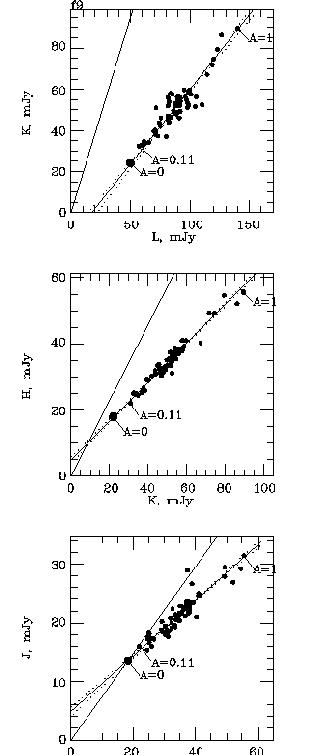Variations of AGNs
Early work on Active Galactic Nuclei
My infrared photometry of AGNs started in 1972 with JHKL observations of the southern Seyferts known at the time, as well as the Sersic and Pastoriza (PASP, 77, 287, 1965) galaxies, which are now known to (mostly) have giant HII regions in their centres. Several S & P galaxies showed infrared excesses, presumably due to the dust in these HII regions (MNRAS, 164, 155, 1973; 175, 191, 1976).
Variability and delayed IR response
A paper on the luminous Seyfert 1 galaxy Fairall 9, by Clavel, Wamsteker and Glass (1989 ApJ, 337, 236) showed a very well-defined delay between variations in the UV (from IUE) and those in the IR (made from the ground). The delay time corresponds to the light travel time from the nucleus of the galaxy to the radius at which the most refractory dust particles are able to exist (at ~1500K).

The figure above shows the final light curves for Fairall 9, taken from my 2004 paper (see below) entitled Long-term IR photometry of Seyferts. To see the IUE data, which cover the earlier epochs, please consult the Clavel et al paper.
The highly variable Seyfert NGC3783 also shows some evidence for a delay between its U-band variations and those at K (MNRAS, 256, 23p, 1992).
Unusual variability
The archetype Seyfert 2, NGC1068, showed a steady, smooth, rise in its near-infrared output over many years, but has now begun what looks like an equally steady decline (MNRAS, 276, L65, 1995). For connection with H_2O maser activity, see Gallimore et al ApJ, 556, 694, 2001.
The x-ray intermediate-type Seyfert NGC2992 has a light curve which shows an outburst with a sharp onset and a decline over several years. The energy involved was comparable to the total energy of a luminous supernova, but this may have been fortuitous (MNRAS, 292, L50, 1997).
The Seyfert NGC7469 ceased for a short time to be a Seyfert 1 galaxy - this event was simultaneously measured by the Crimean group with visible photometry and spectroscopy (MNRAS, 297, 18, 1998).
Flux Variation Gradients
Winkler et al (MNRAS 257, 659, 1992) rediscovered a result originally found by Choloniewski (Acta Astr, 31, 293, 1981) that the variable parts of the UBVRI fluxes from Seyfert 1s are linearly correlated. Winkler showed that they tend to have standard colours, except as modified by interstellar reddening.
Similar behaviour is found in the JHKL region, but the optical and IR variations are not well correlated. An example is NGC3783 (MNRAS 256, 23p, 1992)

|
The figures to the left show the fluxes from Fairall 9 through a constant aperture at different times, plotted against each other. The regression lines through the observed points are shown, together with the expected position of an "ordinary galaxy" component in each diagram. The diagrams can be analysed to yield the underlying galaxy component of flux as well as to infer that there is a cool dust component present that does not vary. The analysis is discussed in detail in the paper Long-term IR photometry of Seyferts, MNRAS, 350, 1049, 2004. high-resolution .pdf version (2MB) Note: the x-axis of the bottom diagram is the H flux |